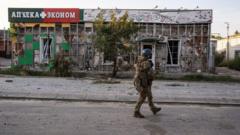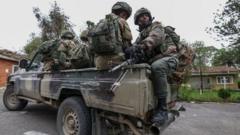In the aftermath of a 15-month long conflict and with ongoing restrictions, Gaza's humanitarian situation remains critical, despite increased aid flow since the cease-fire.
Gaza Faces Urgent Humanitarian Crisis Despite Recent Aid Influx

Gaza Faces Urgent Humanitarian Crisis Despite Recent Aid Influx
Recent cease-fire leads to much-needed humanitarian assistance as Gaza continues to grapple with severe shortages.
Outside a warehouse in southern Gaza, a crowd of men and boys eagerly awaited essential supplies this week, a scene all too rare since the onset of war 15 months ago. They departed with bags of flour and food boxes, often dragging their meager provisions away in two-wheeled carts. This chaotic distribution has shifted, now appearing to be more organized, as humanitarian aid finally trickles into a territory beleaguered by war and deprivation.
As the conflict paused with a cease-fire agreement, aid officials and residents report that essential deliveries have ramped up, yet concerns grow over sustaining this level of assistance amid logistical difficulties and uncertainties surrounding the truce's duration. The interim head of the UN humanitarian office for Gaza, Jonathan Whittall, reported an unprecedented surge in aid movement—with three days’ worth of food deliveries now surpassing what the UN achieved throughout all of October.
The scale of need in Gaza is immense. Aid groups are distributing not only food but also medical supplies, fuel for hospitals, and help to repair crumbling infrastructure. Aid is expected to further expand with plans for sending tents and the reopening of bakeries set to ensure the supply of bread in the coming days.
Despite these hopeful signs, observers remain cautious. While the immediate hunger and need are being addressed, the overall situation in Gaza leaves much to be desired. The challenge in maintaining sufficient aid underscores the fragility of the recent cease-fire and the broader implications for peace and stability in the region.
As the conflict paused with a cease-fire agreement, aid officials and residents report that essential deliveries have ramped up, yet concerns grow over sustaining this level of assistance amid logistical difficulties and uncertainties surrounding the truce's duration. The interim head of the UN humanitarian office for Gaza, Jonathan Whittall, reported an unprecedented surge in aid movement—with three days’ worth of food deliveries now surpassing what the UN achieved throughout all of October.
The scale of need in Gaza is immense. Aid groups are distributing not only food but also medical supplies, fuel for hospitals, and help to repair crumbling infrastructure. Aid is expected to further expand with plans for sending tents and the reopening of bakeries set to ensure the supply of bread in the coming days.
Despite these hopeful signs, observers remain cautious. While the immediate hunger and need are being addressed, the overall situation in Gaza leaves much to be desired. The challenge in maintaining sufficient aid underscores the fragility of the recent cease-fire and the broader implications for peace and stability in the region.






















